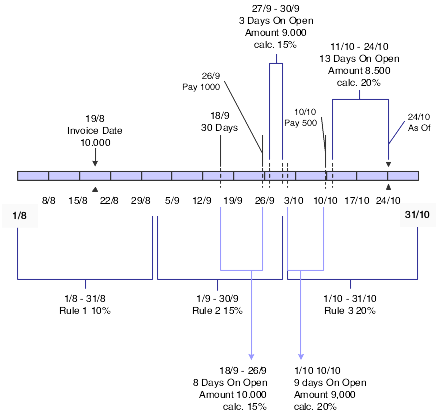30 Day Rule Method
The system writes to two additional tables when you use the 30-day rule method to calculate delinquency fees. The Processed Documents in Finance Charge Process table (F74P3B24) includes the ending date for the period for which each fee is calculated for each invoice. The system also writes data to the A/R Fee Journal History Detail for Poland table (F74P3B23). The system uses the information in this table when you generate the A/R Delinquency Fee Journal For Poland report (R74P3B22).
This diagram shows how the system processes delinquency fees using the 30-day rule method:

When you set the 30 Day Rule processing option to specify that the system uses the 30-day rule method, the system:
Calculates the delinquency fee for the number of days for which the entire invoice amount is overdue.
The system uses the invoice date, shipment date, or delivery date, plus 30 days as the beginning of the period for which it calculates the delinquency fees, and uses the earlier of the invoice due date or the as of date as the end of the calculation period. If the period for which the entire amount is past due spans more than one interest rate as set up in the Define Delinquency Policies program (P03B2501), the system calculates the delinquency fee for the number of days for which the amount is past due for each interest rate in effect.
If a partial payment is made, calculates the delinquency fee for the number of days for which the open amount is overdue up to invoice due date or the as of date, whichever date is earlier.
For the partially paid amount, the system calculates the fees up to the receipt clear date or receipt GL date according to processing option setup.
For example, if the customer makes a 1000 payment on a 10,000 invoice, the system calculates the delinquency fee on 10,000 up to the date on which the amount is paid. The system also calculates delinquency fees on 9000 up to the invoice due date or the as of date, whichever date is earlier. If you set the processing options to use the receipt cleared date, the system uses that date instead of the payment date to determine the number of days for which to calculate the delinquency fee.
If the period for which the entire amount is past due spans more than one interest rate, the system calculates the delinquency fees for the number of days for which the amount is past due for each interest rate in effect. When the final payment is made, the system calculates the delinquency fee from the date of the last delinquency fee calculation until the date of the earliest occurring of the invoice due date, the as of date, or the receipt cleared date or receipt GL date. In the example in this section, the delinquency fees would be calculated on the 9000 that was canceled in the last receipt.
If the period for which the entire amount is past due spans more than one interest rate, the system calculates the delinquency fees for the number of days for which the amount is past due for each interest rate in effect.